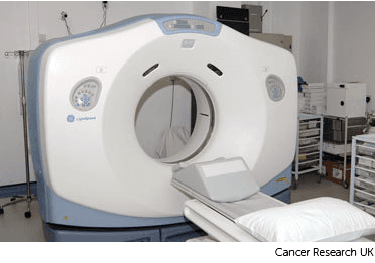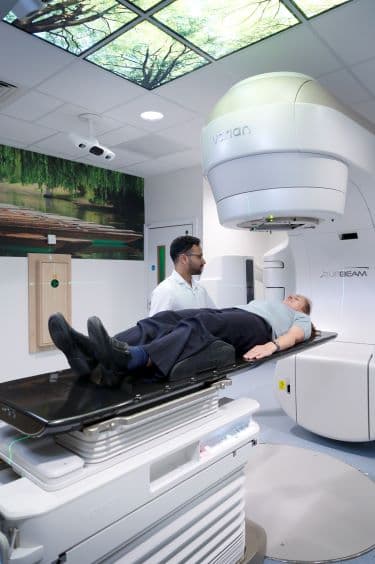Treatment
Radiotherapy treatment works by damaging the DNA within the cancer cells. DNA is the genetic code that controls how the body's cells behave.
You might have radiotherapy to:
reduce the size of the cancer so that surgery might be possible, this is usually as part of a
shrink and control the cancer for as long as possible
help relieve symptoms
You might have radiotherapy on its own or with chemotherapy (chemoradiotherapy).
Having chemotherapy helps the radiotherapy work better but can also increase side effects. For chemoradiotherapy you usually have the chemotherapy drug capecitabine.
Chemoradiotherapy has largely been replaced by a type of radiotherapy called stereotactic body radiotherapy (SBRT). But it isn’t available in all UK hospitals.
Stereotactic body radiotherapy is a type of external radiotherapy. External radiotherapy uses a machine outside the body to direct radiation beams at the cancer to destroy it.
You might have this if you have locally advanced pancreatic cancer or borderline resectable cancer. This means that the cancer is in the pancreas and has started to involve the nearby blood vessels.
SBRT gives radiotherapy from many different positions around the body. The beams meet at the tumour. This means the cancer receives high amounts (doses) of radiation, but the surrounding tissues only get a low dose. This lowers the risk of side effects.
Your healthcare team will explain the type of radiotherapy treatment you will be having.
Find out more about stereotactic body radiotherapy
You might have radiotherapy as a single treatment or a series of daily treatment sessions. A single dose of radiotherapy is called a fraction. A series of sessions makes up a radiotherapy course.
You usually have SBRT if it’s available in your hospital. SBRT doesn’t start until at least 2 weeks after you have finished chemotherapy. You don’t have chemotherapy alongside SBRT.
You usually have up to 5 sessions. You have this over 1 to 2 weeks.
About 6 to 8 weeks after the end of SBRT you might have a CT scan. This is to check how well the radiotherapy has worked. Some people with locally advanced pancreatic cancer may be able to go on to have surgery.
If SBRT isn’t available you have a course of radiotherapy over several weeks. For example, chemoradiotherapy lasts about 4 to 5 weeks. Treatment is usually Monday to Friday.
Radiotherapy to relieve cancer symptoms, such as pain, is called palliative radiotherapy. You often have this in fewer fractions and sometimes it is just one treatment. Palliative radiotherapy has fewer side effects.
Your doctor will discuss with you how many sessions you need.
Before you begin your treatment, the radiotherapy team carefully plan your external beam radiotherapy. This means working out how much radiation you need to treat the cancer and exactly where you need it.
Your planning appointment may take from 15 minutes to 2 hours.
You usually have a planning CT scan in the radiotherapy department.
The scan shows the cancer and the area around it. You might have other types of scans or x-rays to help your treatment team plan your radiotherapy. The plan they create is just for you.

Your radiographers tell you what is going to happen. They help you into position on the scan couch.
The CT scanner couch is the same type of bed that you lie on for your treatment sessions. You need to lie very still. Tell your radiographers if you aren't comfortable.
This is a type of dye you drink, it contains iodine. The drink tastes like aniseed. You might have this before your CT scan to show up other organs in the body such as the food pipe (oesophagus), stomach and bowel. It helps your radiographer to plan your treatment.
You might need an injection of dye (contrast) into a vein. This is through a small tube that goes into the back of your hand. It’s called a cannula. The contrast helps body tissues show up more clearly on the scan.
Before you have the contrast, your radiographer asks you about any medical conditions or allergies. Some people are allergic to the contrast.
Once you are in position your radiographers put some markers on your skin. They move the couch up and through the scanner. They then leave the room and the scan starts.
The scan takes about 5 minutes. You won't feel anything. Your radiographers can see and hear you from the CT control area where they operate the scanner.
The radiographers make pin point sized tattoo marks on your skin. They use these marks to line you up into the same position every day. The tattoos make sure they treat exactly the same area for all of your treatments. They may also draw marks around the tattoos with a permanent ink pen, so that they are clear to see when the lights are low.

The radiotherapy staff tell you how to look after the markings. The pen marks might start to rub off in time, but the tattoos won’t. Tell your radiographer if that happens. Don't try to redraw them yourself.
You might have to wait a few days or weeks before you start treatment.
During this time the physicists and your radiotherapy doctor (clinical oncologist) decide the final details of your radiotherapy plan. They make sure that the area of the cancer will receive a high dose and nearby areas receive a low dose. This lowers the side effects you might get during and after treatment.
Read more about radiotherapy planning
Radiotherapy machines are very big and could make you feel nervous when you see them for the first time. The machine might be fixed in one position. Or it might rotate around your body to give treatment from different directions. The machine doesn't touch you at any point.
Before your first treatment, your will explain what you will see and hear. In some departments, the treatment rooms have docks for you to plug in music players. So you can listen to your own music while you have treatment.

The radiographers help you to get onto the treatment couch. You usually lie on your back and might need to raise your arms over your head.
The radiographers line up the radiotherapy machine using the marks on your body. Once you are in the right position, they leave the room.
You need to lie very still. Your radiographers might take images (x-rays or scans) before your treatment. This is to make sure that you're in the right position. The machine makes whirring and beeping sounds. You won’t feel anything when you have the treatment.
Your radiographers can see and hear you on a CCTV screen in the next room. They can talk to you over an intercom and might ask you to hold your breath or take shallow breaths at times. You can also talk to them through the intercom or raise your hand if you need to stop or if you're uncomfortable.
This type of radiotherapy won't make you radioactive. It's safe to be around other people, including pregnant women and children after your treatment.
You might have to travel a long way each day for your radiotherapy. This depends on where your nearest cancer centre is. This can make you very tired, especially if you have side effects from the treatment.
You can ask your radiographers for an appointment time to suit you. They will do their best, but some departments might be very busy. Some radiotherapy departments are open from 7 am till 9 pm.
Car parking can be difficult at hospitals. Ask the radiotherapy staff if you are able to get free parking or discounted parking. They may be able to give you tips on free places to park nearby.
Hospital transport may be available if you have no other way to get to the hospital. But it might not always be at convenient times. It is usually for people who struggle to use public transport. Or who have any other illnesses or disabilities. You might need to arrange hospital transport yourself.
Some people are able to claim back a refund for healthcare travel costs. This is based on the type of appointment and whether you claim certain benefits. Ask the radiotherapy staff for more information about this and hospital transport.
Some hospitals have their own drivers and local charities might offer hospital transport. So do ask if any help is available in your area.
Radiotherapy for pancreatic cancer can cause side effects. You may have only very few side effects, or you may have several. This will depend how long you have radiotherapy for and if you have it with other treatments such as chemotherapy.
The side effects you have will depend on what tissues and organs are in the way of the radiotherapy beam.
Side effects tend to start a week after the radiotherapy begins. They gradually get worse during the treatment and for a couple of weeks after the treatment ends. But they usually begin to improve after around 2 weeks or so.
Some of the side effects include:
You might feel tired during your treatment. It tends to get worse as the treatment goes on. You might also feel weak and lack energy. Rest when you need to.
Tiredness can carry on for some weeks after the treatment has ended. But it usually improves gradually.
Various things can help you to reduce tiredness and cope with it, such as exercise. Some research has shown that taking gentle exercise can give you more energy. It's important to balance exercise with resting.
You might feel sick at times. Let your treatment team know if you feel sick, as they can give you anti sickness medicines.
Radiotherapy to the tummy (abdomen) can cause diarrhoea. Drink plenty of fluids and let your doctor know if you have frequent diarrhoea.
Your skin might go red or darker in the treatment area. You might also get slight redness or darkening on the other side of your body. This is where the radiotherapy beams leave the body.
The red or darker areas can feel sore. Your radiographers will give you creams to soothe your skin. The soreness usually goes away within 2 to 4 weeks of ending the treatment. But your skin might always be slightly darker in that area.
The hair in that area might also fall out.
The following video talks about the general side effects of radiotherapy. This video is around 8 minutes.
Last reviewed: 12 May 2023
Next review due: 12 May 2026
Radiotherapy can cause different side effects depending on which part of the body is being treated. Find out what these side effects are and how they affect you during and after treatment.
Chemotherapy is one of the main treatments for pancreatic cancer. Find out about when you might have it, the types of chemotherapy drugs, how you have it and possible side effects.
Stereotactic radiotherapy is a way of giving radiotherapy to a tumour from different directions. This makes it easier to avoid healthy tissue.
Your treatment depends on the position of the cancer in the pancreas, how big it is, the type of pancreatic cancer it is, whether it has spread, if they can remove it with surgery and your general health.
Researchers around the world are looking into pancreatic cancer and want to find out how its starts, what helps it grow, new tests and treatment. Find out more about the research happening.
Pancreatic cancer is cancer that starts in the pancreas. The pancreas is a gland that produces digestive juices and hormones. Find out about symptoms, tests you might have to diagnose it, treatment and about living with it.

About Cancer generously supported by Dangoor Education since 2010. Learn more about Dangoor Education
Search our clinical trials database for all cancer trials and studies recruiting in the UK.
Connect with other people affected by cancer and share your experiences.
Questions about cancer? Call freephone 0808 800 40 40 from 9 to 5 - Monday to Friday. Alternatively, you can email us.